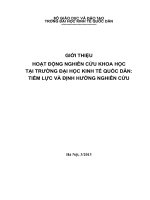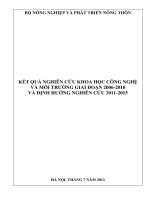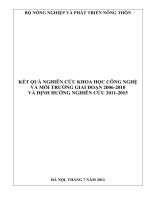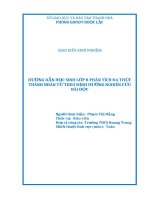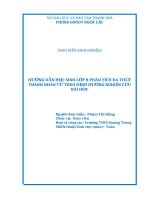0195 vận DỤNG PHƯƠNG PHÁP THÍ NGHIỆM TRONG dạy học KHOA học THEO ĐỊNH HƯỚNG NGHIÊN cứu tại THÀNH PHỐ hồ CHÍ MINH
Bạn đang xem bản rút gọn của tài liệu. Xem và tải ngay bản đầy đủ của tài liệu tại đây (417.94 KB, 15 trang )
TẠP CHÍ KHOA HỌC
TRƯỜNG ĐẠI HỌC SƯ PHẠM TP HỒ CHÍ MINH
Tập 18, Số 11 (2021): 2010-2022
ISSN:
2734-9918
HO CHI MINH CITY UNIVERSITY OF EDUCATION
JOURNAL OF SCIENCE
Vol. 18, No. 11 (2021): 2010-2022
Website:
/>
Research Article
APPLICATION OF EXPERIMENTAL METHODS
TO TEACH SCIENCE SUBJECT FOR PRIMARY STUDENTS IN HO
CHI MINH CITY
Nguyen Minh Giang*, Nguyen Tran Thanh Liem
*
Corresponding author: Nguyen Minh Giang – Email: Received: June
15, 2021; Revised: September 07, 2021; Accepted: October 02, 2021
ABSTRACT
The research has built a process of applying experimental methods in teaching Science composed of
four stages. The design of appropriate teaching activities and the preparation of experimental means for
teaching are important. Students participate in four types of activities including warm-up, inquiry, and
discovery to find out how to perform experiments, report, and application activities. Students' activities start
from asking questions or identifying problem situations related to the lesson requiring to be demonstrated
using experimental methods. At the end of experimental activities, students must find examples of applying
learned knowledge and explaining phenomena that occur in life from simple to advanced levels. The lesson
plan "What properties does water have?" is designed according to the proposed teaching process. Through
the experiment, the lesson plan was found to be effective in developing the natural science competencies for
students according to the requirements of the 2018 Science Curriculum.
Keywords: competence; experimental method; primary; students; science subject; science research
1.
Introduction
Science subject in primary school is built on the basic and original foundation of natural
science and research fields in health education and environmental education. The subject plays an
important role in helping students learn Natural Science at the middle school level and Physics,
Chemistry, and Biology at the high school level. The subject focuses on arousing scientific curiosity,
allowing students to learn and explore nature, applying knowledge and skills into practice, staying
healthy, and behaving appropriately with the surrounding living environment. Students learn science
through inquiry, discovery, observation, experiment, practice, and teamwork. Since then, natural
science competencies have been formed and developed in students (Ministry of Education and
Training, 2018).
Cite this article as: Nguyen Minh Giang, & Nguyen Tran Thanh Liem (2021). Application of experimental methods to
teach science subject for primary students in Ho Chi Minh City. Ho Chi Minh City University of Education Journal of
Science, 18(11), 2010-2022.
1
HCMUE Journal of Science
Nguyen Minh Giang et
al.
In science teaching, students should be offered opportunities to explore possibilities
to resolve differences between current views on a topic and new information or to resolve
conflicts like a scientist (National Research Council, 1997). Therefore, research-oriented
teaching is the choice for modern education. Elken and Wollscheid analyzed and claimed
that the effectiveness of research-oriented teaching depends on the subject, ability, and
level of learners in the study (Elken & Wollscheid, 2016). Research-oriented teaching can
use a combination of teaching methods such as project-based teaching, inquiry-based
teaching, and problem-solving teaching to develop the qualities and competences of
students (Nguyen & Nguyen, 2018). In Vietnam, research-oriented teaching has been
applied to teach natural science subjects in high schools. For example, Phamand
Nguyenapplied this method to teaching physics to high school. In particular, the role of
general research is an emphasis on the process of teaching physics knowledge or the
process of applying physical knowledge in solving practical problems (Pham & Nguyen,
2016). The scientific research orientation has also been implemented in teaching biology
through learning projects (Nguyen & Nguyen, 2019).
In Vietnam, research-oriented education has been applied to teach natural science
subjects in high schools. For example, Pham and Nguyen applied this method to teaching
physical subjects in high school. In particular, the role of general research is the emphasis
on the process of teaching physical knowledge or the process of applying physical
knowledge to solving practical problems (Pham & Nguyen, 2016). The scientific research
orientation has also been implemented in the teaching of biology through learning projects
(Nguyen & Nguyen, 2019).
The teaching of Science in primary schools is implemented according to the
orientation of the 2018 Science Curriculum. The goal is forming and developing natural
science competences for students such as cognise natural science, explore the natural
environment, and apply knowledge and skills (Ministry of Education and Training, 2018).
Research- oriented teaching will meet the objectives and requirements of the subject
curriculum. However, this teaching orientation only applies to high school students, not
with primary level students. It is not too difficult for teachers to use familiar teaching
methods such as experimental methods to follow this teaching orientation. Using the
natural science teaching experiment helps students to test ideas and find relationships
between concepts, or to verify initial hypotheses. The students’ retention (memorization)
level by an experimental method is higher than that of the demonstration or the
explanation. At the same time, the experimental method helps students to discover
knowledge and experience better practical experiences (Veselinovska et al., 2011).
Students develop the ability to do research, being able to ask many appropriate questions
when studying chemistry through experiments (Hofstein et al., 2005).
2
HCMUE Journal of Science
Vol. 18, No. 11 (2021): 20102022
2.
Research Methods
2.1. Theoretical foundation
We searched documents and theories of science-oriented teaching (books, internet,
scientific journals, research works of domestic and foreign authors), psychophysiological
characteristics, content, and teaching natural science by experimental methods for primary
students to \clarify concepts related to the topic.
2.2. Experimental method
To confirm the feasibility and effectiveness of the science teaching plan, the research
has experimentalized with lesson plan "Nature of Water" at two classes of Gradee 4 of
Vinschool Primary School, Ho Chi Minh City. The 4A class is the experimental class and
the 4B class is the control class. Each class has 30 students. Students of both classes will be
evaluated before the experimental teaching. The lesson plans using scientific researchoriented experimental methods were taught for 4A students, while students of 4B class
were taught according to lesson plans using conventional experimental methods. Then,
both experimental and control classes did the same exercise to compare the results. The
experimental period is from March 2, 2021, to March 14, 2021.
2.3. Data analysis
Data before and after the experiment were processed by Oneway ANOVA tool on
SPSS 25.0 software. The conclusions were made based on the following criteria:
Hypothesis H0: there is no significant difference between the two assessment groups.
If .sig < 5%, hypothesis H0 can be rejected.
If .sig >= 5%, hypothesis H0 cannot be rejected.
3.
Research results
3.1. Developing a process for applying experimental methods in teaching science
subject Based on a four step scientific research process: (1) Problem statement; (2)
Research design; (3) Collect, organize and process relevant data and knowledge; (4)
Present research results, and combined with the teaching process by experimental
method to develop the components of natural science competencies for students,
including: cognise natural science, explore the natural environment, and apply
knowledge and skills, we design a teaching
process with four steps:
Step 1. Determine the objectives of the topic/lesson including specific competencies,
general competencies, and qualities.
Step 2. Select the appropriate content and form to use the experimental method in the
lesson.
Step 3. Design appropriate teaching activities that combine with the preparation of
experimental means. In which, students participate in activities starting from warm-up to
active application.
Step 4. Check and evaluate by comparing activities with lesson objectives.
3
HCMUE Journal of Science
Nguyen Minh Giang et
al.
In the above steps, we focused on step 3 which is the selection of content and
organizational form suitable for experimental methods. We designed a lesson plan which
starts from a question or a problem situation related to the lesson that needs to use
experimental methods to demonstrate. This question/situation is done by the students
themselves to develop scientific cognitive competence and explore the natural environment
(The teacher only suggested if that was necessary). Subsequent teaching activities helped
students to answer questions actively. Students have to find out examples of applying their
learned knowledge or explaining phenomena that occur in life from a simple to an
advanced level in the last activities. Specifically, the activities of experimental methods
teach Science in research orientation as follows:
3.2. Build teaching activities in the lesson plan (step 3)
• Activity 1. Warm – up
The warm-up activity in teaching Science by the experimental method starts by
putting students in a situation (in the form of a question, a new situation for students'
perception) so that students need to conduct experiments to solve the problems. Students
think for themselves about how to find answers through individual activities.
• Activity 2. Inquiry and discovery activities through learning how to conduct experiments.
+ Students discuss in groups to choose how to experiment. The members of the team
change with the learning content so every student has the opportunity to express
themselves.
+ Teachers introduce many different tools and materials to perform experiments. In
which there are disturbing materials for students to think about and choose the right way.
+ The group of students select equipment and chemicals for the experiment and send
someone to pick up the means to experiment.
+ Students perform experiments themselves, observe the experimental process and
record predictions, and discuss the experimental results. Besides, when the students
observe and discover strange things, they need to answer the "why" question. After
experimenting successfully, students write down the process in their lesson notebooks.
Teachers pay attention to reminding students to ensure safety.
• Activity 3. Report on activity results
+ Firstly, each group presents its experimental ideas. After that, the teacher chooses
the wrong group to present and do it. The group that does the right thing (good) will
present and do it later.
+ The groups explain the results, answer your questions.
• Activity 4. Summarize and consolidate (practice, apply).
+ Students comment on the experimental results of the groups.
+ Teacher summarizes and consolidates students' knowledge through a game (teacher
gives, asks students to say how to do).
4
HCMUE Journal of Science
Vol. 18, No. 11 (2021): 20102022
+ Students apply learned knowledge through experiments to explain problems that
relate to life.
3.3. Design the illustrative lesson plan
Topic: Substance, SCIENCE 4
Lesson: What properties does water have?
Duration: 1 period
1. Objectives
Competences
and qualities
Scientific
compenteces
Target
General
compenteces
Main qualities
Encode
State the properties of water.
Presentations are predictions about the properties of water.
The proof is predicted by experimenting.
Apply the properties of water to life.
(1)
(2)
(3)
(4)
Problem solving and creativity: practice creative experiments
in different ways.
Honesty: When reporting experiments.
Hardworking: Enthusiastic to participate in individual and class
activities.
Responsibilities: Together with class members to complete the
learning task.
(5)
(6)
(7)
(8)
2. Preparation of teachers and students
Work
Activity 1
Teacher's preparation
01 bottle of water, 04 bottles of water of
the same type
Activity 2
Activity 3
Students’ preparation
- Group table
-
-
- Experiment 1: water, strawberry milk,orange juice, tea, milk coffee.
Experiment 2: Container (vase, bowl,
cup, box), water, oil.
Experiment 3: water, sugar, salt, sand,cooking oil, spoon.
Experiment 4: meca sheet, plastic, wood,(40cmx50cm), 01 pieces of foam,
aluminum tray (50cmx60cm).
Experiment 5: Plastic tray, tissue paper,
cloth, cotton, sand.
5
Experiments 1, 3: 05 sets of
transparent plastic cups with the
same shape and size, 02 cups with
different shapes and sizes.
Experiment 2: absorbent paper, 01
plastic bottle.
Experiment 4: 01 plastic sheet
(40cmx50cm), A4 paper.
Experiment 5: aluminum tray,
nylon bag.
HCMUE Journal of Science
-
-
-
-
Nguyen Minh Giang et
al.
3. Teaching activities
3.1. Warm-up activity
a) Objectives: 1, 7
b) Method: Questions and answers
c) Organizational process:
Teacher asks students to present their knowledge about the water.
The teacher prepares 5 bottles that are the same and transparent: Bottle number 1 contains
water and the remaining 4 bottles have no water, the observation distance is 2m enough for
students to identify difficulty.
+ Students observe and determine: (1) Which bottles have /do not contain water; (2)
Why are there different results?
+ The teacher leads the lesson: What are the properties of water and how are the
properties of water applied in life?
d) Expected product:
Students' answers about some properties and roles of water.
(1) Students find the bottle with water by guessing.
(2) Because all 5 bottles are colorless and transparent; Bottle 1 contains water and
transparency is a property of water.
3.2. Activity 2: Proposing questions and ways to find answers
a) Objectives: 2, 7, 8
b) Teaching methods and techniques: cooperative teaching, tablecloth techniques.
c) Organizational process:
Students work in groups of five members according to the tablecloth technique, record their
initial understanding of the properties of water on the group board. At the same time, each
group mentioned at least three questions to find out about the properties of water.
Students present group work products.
The teacher synthesizes the questions of the groups (editing and grouping the questions
under the content of learning about the properties of water, including: (1) What is the color,
smell, and taste of water?; (2) What is the shape of water?; (3) What substances can/cannot
dissolve?; (4) How does water flow?; (5) Does water can be permeable through some
objects?
+ The teacher requests students to give answers to the above questions and answer
the question: Is there a way to prove that feature (property) of water?
d) Expected product: Students can present some characteristics of water and ask
questions to find out the properties of water. Proposing a way to prove the properties
of water by experiment.
6
HCMUE Journal of Science
Vol. 18, No. 11 (2021): 20102022
3.3. Activity 3: Make predictions, propose experimental options and draw conclusions
a) Objectives: 2, 3, 6, 7, 8
b) Teaching methods and techniques: experiments, cooperative teaching
c) Organizational process:
- Divide students in class into five groups;
- The teacher introduces five experimental kits prepared for studying the properties of water.
For each set of tools, the teacher prepares one to two extra tools/materials for interference
so that students in the group have to discuss and choose the right equipment and
experimental materials.
- Each group draws lots and chooses kits and materials suitable for the assigned task of the
group.
Group
first
2
3
4
5
Guess
What is the color, smell, and taste of water?
What is the shape of water?
Water dissolves/insoluble some substances
How does the water flow?
Water does/doesn't seep through some objects
- Students experiment, record the experiment progress and results.
- Students: Compare the experimental results with the original prediction and draw
conclusions about the properties of water.
- The representative student of each group present the results and conclude.
d) Expected product
Group
1
2
Expected product
- Students choose tools and materials to experiment, including five same cups, water,
strawberry milk, tea, orange juice, coffee milk, spoon: Cup 1 is water, cup 2 is
strawberry milk, cup 3 is orange juice, cup 4 is tea, cup 5 is milk coffee. Students use
eyes, tongue, and nose to identify properties.
- Students explain the predicted results: Because water is colorless, odorless,
tasteless. Orange juice, strawberry milk, coffee with color, smell, and taste.
- Students conclude: Water is a clear, colorless, odorless, and tasteless liquid.
- Students choose experimental tools including four containers (jar, bowl, cup, box)
and water;
- Students experiment to observe the shape of water.
- The water will have the same shape as the container.
- Students conclude: Water does not have a definite shape but has the shape of a
container.
7
HCMUE Journal of Science
3
4
5
Nguyen Minh Giang et
al.
- Students' choice of instrument testing: four same cups, sugar, salt, sand, cooking oil,
spoon.
- Students make predictions about water solubility.
- Experiment: put half a teaspoon of substances in 4 cups with the same amount
of water, stir with a spoon to know if the substance is soluble in water or not.
- Students conclude: Water can dissolve sugar, salt; Insoluble sand; Cooking oil.
- Students choose experimental tools: meca plate or 01 plastic sheet (40cmx50cm),
water.
- Students can perform experiments:
- Students can answer some information for the question: How will the water flow?
* Water flows straight down.
* Water flows from top to bottom.
* Water flows in many streams from top to bottom.
* Water flows to the tray, then spreads to all sides.
* Water flows from above, spreading to all directions.
* Water flows from high to low, to the tray the water spreads to all sides.
- Students conclude: Water flows from low pipes, spreading to all sides.
- Students' choice of instrument testing: four same cups, sugar, salt, sand, oil, spoon.
- Students make predictions about water solubility with materials.
- Experiment: put half a teaspoon of substances in four cups with the same amount
of water inturn, stir with a spoon to know if the substance is soluble in water or not.
- Students conclude: Water can dissolve sugar, sal, and insoluble sand, cooking oil.
3.4. Contact with practice
a) Objectives: 4, 8.
b) Method: Game-based learning.
c) Organizational process:
+ In 3 minutes: Students in groups record the applications of water properties in
human life and explain?
+ The group students will win if they score the most correct answers and explain the
properties of water in three minutes.
d) Expected product
+ Water is a clear, colorless, odorless, tasteless liquid: Use water to cook rice, ...
+ Water has no definite shape: Humans create aquariums of many shapes, ...
+ Water dissolves certain substances: Humans make many attractive and healthy
drinks such as lemonade, orange juice, ...
+ Water flows from high to low, spreading in all directions: People make
waterfalls, artificial springs, sprinklers, water plants, make sloping roofs, make hats...
+ Water can be permeable/can not permeable some objects: People wear
raincoats, shoes, plastic slippers to not get wet, produce water containers such as
aluminum kettles,
8
HCMUE Journal of Science
Vol. 18, No. 11 (2021): 20102022
buckets, pots, towels to dry people after bathing, making many types of paper, specialized
wipes to help clean, clean the house...
* Expected assessment: Checklist for the lesson
Criteria
Yes
No
Select specimens and instruments that meet the requirements of the test.
State the experimental questions.
State the experimental hypothesis.
Design experimental steps.
Perform experimental operations competently.
Complete experimental record.
Explain experimental results clearly.
Draw correct conclusions.
Contact and apply the properties of water in practice
3.3. Pedagogical experiment
Before experimental teaching, two groups of experimental and control students in
grades 4A and 4B took the test in Appendix 1 (skip question number 6). In the
questionnaire, we divided it into three levels corresponding to the three components of
natural science compentences: cognise natural science (questions 1, 2, 3), explore the
natural environment (questions 4), and apply knowledge and skills (questions 5). A Postexperiment test was performed on both groups (experimental group, control group) to
determine the level and effectiveness of using experimental methods. Table 3.1 shows the
results of students’ tests.
Table 3.1. Student’s test results after the experiment
Competences
Question
1
Cognise natural science
2
3
Explore the natural environment
4
Apply knowledge and skills
5
9
Scores
Experimental
group
Control
group
3
2
1
26
2
2
16
8
4
0
1
0
0
25
5
2
22
8
1
0
3
27
3
22
22
8
18
2
1
0
2
1
5
2
1
24
5
10
2
0
16
7
HCMUE Journal of Science
0
1
Vol. 18, No. 11 (2021): 20102022
7
10
HCMUE Journal of Science
Nguyen Minh Giang et
al.
The Oneway-ANOVA test shows that there is a significant differencebetween the
experimental and control groups (Table 3.2).
Table 3.2. Post-experiment analysis results
The compentences
Question
Cognise natural
science
Explore the natural
environment
Apply knowledge
and skills
Experimental group
Medium
Standard
score
deviation
Control group
Medium
Standard
score
deviation
.Sig
1
2
3
4
2.8
0.83
0.9
2.6
0.56
0.38
0.31
0.77
2.27
0.73
0.73
2.53
0.95
0.45
0.45
0.63
0.001
0.39
0.36
0.049
5
1.77
0.50
1.3
0.84
0.002
- In the control group:
+ The scientific cognitive competences: students of the control group could only
observe the teacher experimenting without directly being involved in the experiment, so
only 16/30 students got the maximum score in questions 1, 22/30 students achieved the
maximum score in questions 2 and 3. At the same time, students did not master the
knowledge and fully state the properties of water and their applications.
+ The competences to explore the natural environment: The results show that 18/30
students had knowledge related to the experiment and 10/30 students can reach 2/3 of the
maximum score. Thus, the fact that students can only observe teachers doing experiments,
but not directly implementing them so they have been limited learning activities to
inculcate knowledge for students.
+ The competences to apply knowledge and skills: In the process of participating in
the lesson, students of the control class did not pay attention to the experiment process
because they were still passive or the experiments were too abstract for their ability. This is
reflected in the fact that 16/30 students applied the properties of water to explain
phenomena and events in life.
- In the experimental group:
+ The scientific cognitive competences: The results show that 26/30 students
achieved the maximum. Thus, the teacher used the experimental method according to the
proposed process. This led to a clear difference in teaching effectiveness. Students
participated in all steps in the learning process. This helped create interest in students and
help them more learn more This is the basis for developing students' scientific cognitive
competences.
11
HCMUE Journal of Science
Vol. 18, No. 11 (2021): 20102022
+ The competences to explore the natural environment: The results show that 22/30
students achieved the maximum score. Most students were able to do experiments well,
memorized knowledge, and analyzed experimental results.
+ The competences to apply knowledge and skills: The results show that 24/30
students in the experimental class got the maximum score on question 5. Thus, when
students participated in different stages in the experiment process, which was just enough
for themselves, stimulated them to find and explore.Especially, students can apply the
results of the experiment in daily life.
At the same time, the results in Table 3.2 show that there is no medium score in any
compentences of the experimental group lower than that of the control group. The students
of the experimental group have better scientific compentences than students of the control
group. This result shows that using experimental methods will be more effective and
competencies are formed better than teaching without using experimental methods. The
standard deviation of the scores in the experimental group is smaller than the standard
deviation of the scores in the control group (in 4/5 questions, except for question 4). Mean
that students in the experimental class have a more equal level of ability than the control
group. Thus, using experimental methods not only improves students' competences but
also helps to create a balanced and effective class.
On the other hand, through actual observation and testing, we find that the class uses
lively experimental methods, students are interested and enthusiastic about activities,
express their understanding and creativity, and they can believe in themselves. In contrast,
the students in the control group were not promoted to be creative and positive in class.
The experimental results show the effectiveness of experimental teaching to develop
learners' competences. Thus, we can confirm the correctness and reality of our research
topic.
4. Conclusion
Based on theoretical research on the use of experimental methods in teaching and
theory on teaching Science subject to the orientation of competence development, the
research has built a teaching process in four steps. The results of the pedagogical
experiment shows that the teaching process and plan make a difference compared to
traditional teaching methods to form and develop students' scientific competences.
Conflict of Interest: Authors have no conflict of interest to declare.
12
HCMUE Journal of Science
Nguyen Minh Giang et
al.
REFERENCES
Avi Hofstein, Oshrit Navon, Mira Kipnis, Rachel Mamlok-Naaman (2005). Developing students'
ability to ask more and better questions resulting from inquiry-type chemistry laboratories.
Journal of Research in Science Teaching, 42(7), 791-806. doi: 10.1002/tea.20072
Mari Elken, & Sabine Wollscheid (2016). The relationship between research and education:
typologies and indicators. A literature review. Nordic Institute for Studies in Innovation,
Research and Education (NIFU), (8), 1-68.
Ministry of Education and Training (2018). Overall general education program (No. 32/2018/TTBGDDT dated December 26, 2018.
National Research Council (1997). Science Teaching Reconsidered: A Handbook. Washington, DC:
The National Academies Press. />Nguyen, T. T., & Nguyen, V. H. (2019). Learning project building process on development of
scientific research compenteces for high school student. Education Magazine, (464) (Term 2
- 10/2019), 60-64.
Nguyen, V. K., & Nguyen, V. N. (2018). Overview of teaching Physics in high school based on
scientific research process. Education Magazine, (428) (Term 2-4/2018), 51-53.
Nguyen, X. L., & Pham, H. H. (2015). Research-oriented teaching approach in technology teachers
training. Hnue Journal of Science, Educational Sci., 60(8D), 29-36. doi: 10.18173/23541075.2015-0252
Snezana Stavrova Veselinovska (2011). The effect of teaching methods on cognitive achievemen,
retention and attitude among in biology studying. Cypriot Journal of Educational Sciences,
(4), 175-185.
APPENDIX 1. STUDENT SURVEY FORM WHEN EXPERIMENTING
13
HCMUE Journal of Science
Vol. 18, No. 11 (2021): 20102022
VẬN DỤNG PHƯƠNG PHÁP THÍ NGHIỆM TRONG DẠY HỌC KHOA HỌC
THEO ĐỊNH HƯỚNG NGHIÊN CỨU TẠI THÀNH PHỐ HỒ CHÍ MINH
Nguyễn Minh Giang*, Nguyễn Trần Thanh Liêm
Trường Đại học Sư phạm Thành phố Hồ Chí Minh, Việt Nam
*
Tác giả liên hệ: Nguyễn Minh Giang – Email:
Ngày nhận bài: 15-6-2021; ngày nhận bài sửa: 07-9-2021; ngày duyệt đăng: 02-10-2021
TÓM TẮT
Nghiên cứu đã xây dựng được quy trình vận dụng phương pháp thí nghiệm trong dạy học
Khoa học theo định hướng nghiên cứu khoa học theo 4 bước. Việc thiết kế các hoạt động dạy học
phù hợp và chuẩn bị các phương tiện thí nghiệm cho dạy học là rất quan trọng. Học sinh được chủ
động tham gia 04 loại hoạt động gồm: khởi động, tìm tịi và khám phá để tìm hiểu cách thức thực
hiện thí nghiệm, báo cáo hoạt động và vận dụng. Hoạt động của học sinh bắt đầu từ việc tự đặt
câu hỏi hoặc xác định tình huống có vấn đề liên quan đến bài học cần sử dụng phương pháp thí
nghiệm để chứng minh, giáo viên chỉ gợi ý khi cần thiết. Kết thúc các hoạt động thực hiện thí
nghiệm, Học sinh phải tìm ra được các ví dụ vận dụng kiến thức đã học, giải thích được các hiện
tượng xảy ra vào trong cuộc sống từ mức độ đơn giản đến mức độ nâng cao. Kế hoạch bài dạy
“Nước có tính chất gì” được thiết theo qui trình dạy học đã đề xuất. Thơng qua việc thực nghiệm
kế hoạch bài dạy đã chứng minh có hiệu quả tốt trong việc phát triển các thành phần năng lực
khoa học tự nhiên cho học sinh theo yêu cầu của chương trình mơn Khoa học 2018.
Từ khóa: năng lực; phương pháp thí nghiệm; học sinh; tiểu học; khoa học; nghiên cứu
khoa học
14


